Triple Crown Winner Profiles
There have been 12 Triple Crown winners in history, with 11 of them winning under the current format featuring the Kentucky Derby as the first leg, the Preakness Stakes second, and the Belmont Stakes third. (There have been years where these races were run out of order for various reasons, but the vast majority of the Triple Crown era has been formatted per the above circuit.)
KentuckyDerbyPreview.com knows Triple Crown winners historically come in bunches, there are often decades-long gaps between winners or groups of winners, making the Triple Crown one of the most uncommon feats in all of sports. Every Triple Crown winner has been a colt, though geldings and fillies have been contenders a handful of times over the series’ 138 eligible runnings.
(There was no Preakness Stakes held from 1891-1893, and the Belmont Stakes was canceled in 1911 and 1912, making the Triple Crown impossible those seasons. However, different horses won each of the remaining two legs those years, so historically, no Triple Crown contender is likely to have missed out. That said, the three years the Preakness was canceled could conceivably have prevented a contender from rising through the ranks.)
| Race Day: |
| September 5, 2020 |
| Post Time: |
| 7:01pm EDT |
| Horse Track: |
| Churchill Downs |
| Track Location: |
| Louisville, Kentucky |
| Track Length: |
| 1.25 Miles |

- Kentucky Derby: 2:09.8, 5 lengths
- Preakness Stakes: 1:53.0, 4 lengths
- Belmont Stakes: 2:17.4, 5 lengths
- Career Record: 31:13-6-5
- Inducted Into Hall of Fame: 1957
- Blood-Horse Magazine Top-100 Ranking: 49
- Career Winnings: $116,857 ($1,653,466)
Sir Barton was the very first Triple Crown winner (though that term had yet to be used to mark the achievement), having accomplished the feat in 1919. Bred in Kentucky by John E. Madden at Hamburg Place Farm outside of Lexington in 1916, Sir Barton’s bloodline included his paternal grandsire Isinglass, who won the English Triple Crown in 1893.
Sir Barton was not expected to win the first leg of the Triple Crown, as he was slated to run support as the “rabbit” for the race favorite, gelding Billy Kelly. However, Sir Barton actually won the Derby wire-to-wire, leading through all 10 furlongs and winning by five lengths. As a side note to Sir Barton’s incredible year, it is important to note that, at the time of his running, the Belmont Stakes (known as last and longest leg of the Triple Crown) was actually only 10.5 furlongs in length (1.375 miles) compared to the modern era’s 12-furlong track (1.5 miles). Sir Barton died at the age of 21 in 1937.
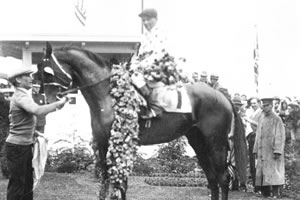
- Kentucky Derby: 2:07.6, 2 lengths
- Preakness Stakes: 2:00.0, 0.75 lengths
- Belmont Stakes: 2:31.6, 3 lengths
- Career Record: 17:11-3-2
- Inducted Into Hall of Fame: 1957
- Blood-Horse Magazine Top-100 Ranking: 28
- Career Winnings: $328,165 ($4,810,191)
Gallant Fox was born in 1927 at Claiborne Farm in Paris, Kentucky. In 1930, the Preakness was held before the Kentucky Derby, and Gallant Fox was the favorite to win both races, which he did, by 0.75 lengths and 2 lengths, respectively. He then won the Belmont Stakes by defeating race favorite Whichone.
For this achievement, a Daily Racing Form article dubbed him the “Triple Crown” winner, a characterization coined (or at least popularized) by writer Charles Hatton. After his racing career, Gallant Fox immediately sired the next Triple Crown winner, Omaha. Gallant Fox remains the only Triple Crown winner to directly sire another Triple Crown winner, and he died in 1954 at the age of 27.
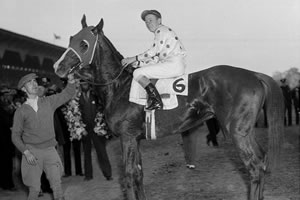
- Kentucky Derby: 2:05.0, 1.5 lengths
- Preakness Stakes: 1:58.4, 6 lengths
- Belmont Stakes: 2:30.6, 1.5 lengths
- Career Record: 22:9-7-2
- Inducted Into Hall of Fame: 1965
- Blood-Horse Magazine Top-100 Ranking: 61
- Career Winnings: $154,755 ($2,765,099)
Omaha, the son of Gallant Fox, followed directly in his father’s footsteps by winning the 1935 Triple Crown. Like his old man, Omaha was from Claiborne Farms in Paris, Kentucky, where he was foaled in 1932. At the Kentucky Derby, Omaha was second-favorite on the betting boards, and he won in rainy conditions by a length and a half. For the Preakness Stakes, Omaha was now the favorite, and he won by six lengths. In the Belmont, Omaha was again the favorite, and – covered in mud – he won by 1.5 lengths to claim the Triple Crown. Omaha died in 1959 at the age of 27. Like father, like son, in every way.
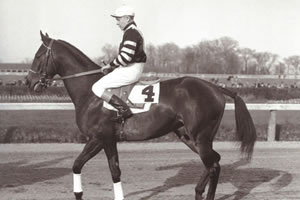
- Kentucky Derby: 2:03.2. 1.75 lengths
- Preakness Stakes: 1:58.4, head
- Belmont Stakes: 2:28.6, 3 lengths
- Career Record: 26:21-3-1
- Inducted Into Hall of Fame: 1958
- Blood-Horse Magazine Top-100 Ranking: 13
- Career Winnings: $273,240 ($4,644,814)
Born at Faraway Farm in Lexington, KY, War Admiral was the son of the famed Man O’ War, who is considered one of history’s finest Thoroughbreds. A particularly small horse (15.3 hands in height), War Admiral was sometimes called “The Mighty Atom,” and he won the Kentucky Derby as the favorite, finishing just 1.75 lengths ahead of his closest competition, Pompoon. With the Preakness held just one week later (which is unusual, as the horses are generally given two weeks between the Derby and the Preakness), War Admiral was again the favorite, and he again beat Pompoon, this time by just a head.
Favored to win the Belmont, War Admiral delayed the start of the race by acting up in the stalls (which he had done in the first two legs as well), and then immediately stumbled at the start. However, he ended up winning by 3 lengths. Even more impressively, he did so on an openly-bleeding right fore-foot, which caused him to miss the rest of the racing season.
War Admiral was inducted into the National Museum of Racing and Hall of Fame in 1958 (along with his cousin and arch-rival Seabiscuit) and died in 1959 at the age of 25. American Pharoah, the last Triple Crown winner to date, is a direct descendant of War Admiral.
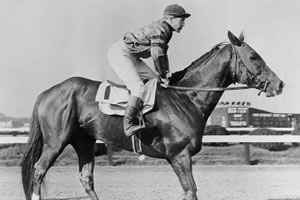
- Kentucky Derby: 2:03.2. 1.75 lengths
- Preakness Stakes: 1:58.8, 5.5 lengths
- Belmont Stakes: 2:31.0, 2.5 lengths
- Career Record: 60:32-15-9
- Inducted Into Hall of Fame: 1958
- Blood-Horse Magazine Top-100 Ranking: 26
- Career Winnings: $561,161 ($9,344,514)
Born in 1938 at Calumet Farm in Lexington, KY, Whirlaway is the only horse in history to win both the Triple Crown and the Travers Stakes, and he was voted Horse of the Year in 1941. In the Kentucky Derby, Whirlaway won by 8 lengths, which remains a course record to this day. Perhaps more impressively, he was the last horse out during the Preakness Stakes, lagging far behind the pack for the first half of the race before rocketing down the stretch to win by 5.5 lengths. By the time he ran the Belmont, many competitors withdrew, leaving only three other horses in the race, which Whirlaway won easily with a leisurely time of 2:31. Whirlaway also has the most career races of any Triple Crown winner with 60. (Citation ran the next most career races with 45.) Whirlaway died in 1953 at the age of 15.
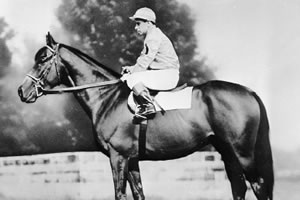
- Kentucky Derby: 2:04, 3 lengths
- Preakness Stakes: 1:57.4, 8 lengths
- Belmont Stakes: 2:28.2, 25 lengths
- Career Record: 21:16-4-1
- Inducted Into Hall of Fame: 1961
- Blood-Horse Magazine Top-100 Ranking: 5
- Career Winnings: $250,300 ($3,541,615)
Count Fleet, born at the Stoner Creek Stud farm in Paris, Kentucky, in 1940 – was like the honey badger: he simply did not care. He’d act a fool in training, injure himself, and then go out and destroy the competition every race day. It was kind of his M.O. In the 1943 Kentucky Derby, Count Fleet went into the race as the favorite, winning by over 3 lengths. In the Preakness Stakes, he was again the favorite, and he beat the diminished field of three competing horses by 8 lengths. Then, in the Belmont – this time running against only two other horses (there was a war on, after all) – Count Fleet was an overwhelming favorite (-2000), clocking the best race time in history to that point: 2:28.20. He also won by 25 lengths, a record that would stand for 30 years.
Count Fleet went on to produce a number of successful offspring, and he died in 1973 at the old age of 33. Count Fleet remains the oldest-lived Kentucky Derby and Preakness Stakes winner, as well as the oldest-lived Triple Crown champion in history.
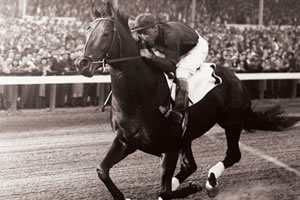
- Kentucky Derby: 2:06.6, 8 lengths
- Preakness Stakes: 2:01.4, neck
- Belmont Stakes: 2:30.8, 3 lengths
- Career Record: 42:18-6-7
- Inducted Into Hall of Fame: 1964
- Blood-Horse Magazine Top-100 Ranking: 33
- Career Winnings: $675,470 ($8,479,262)
Assault was the first of the Triple Crown champions not born in Kentucky, as he hailed from the famed King Ranch in Texas. His father, Bold Venture, won both the Kentucky Derby and Preakness Stakes, but failed to take the Belmont Stakes. In a tale as old as time, his son would eventually one-up the old man.
Assault’s career started slow, as he was often injured and described by one of his jockeys as “delicate.” However, as an underdog at the Kentucky Derby, he surprised the field – and the crowd – by winning the race by 8 lengths, tying the record set by Whirlaway 5 years prior. Favored in the Preakness Stakes, Assault barely edged out a victory, winning by a neck against Lord Boswell. A perceived lack of stamina in the Preakness had racebooks down-rank Assault for the longer Belmont Stakes, where he lagged behind the field before passing the crowd in the final 200 yards to win by 3 lengths.
Assault was unable to retire to stud, as he was thought to be sterile, and so he raced until he was 7 years old before retiring for good. He died at King Ranch in 1971 at the age of 28.
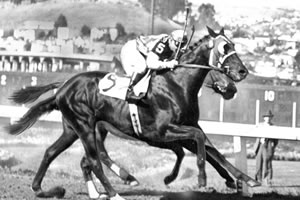
- Kentucky Derby: 2:05.4, 3.5 lengths
- Preakness Stakes: 2:02.4, 5.5 lengths
- Belmont Stakes: 2:28.2, 8 lengths
- Career Record: 42:18-6-7
- Inducted Into Hall of Fame: 1959
- Blood-Horse Magazine Top-100 Ranking: 3
- Career Winnings: $1,085,760 ($11,028,168)
Sometimes referred to as “The Great Citation” or “The Mighty Citation,” Citation was – up to that point – the finest racehorse in history. Born at Calumet Farm in Lexington, KY, Citation had a largely European background, giving him a combination of size and speed rarely seen before in Thoroughbred horse racing. He won the Kentucky Derby by 3.5 lengths, the Preakness Stakes by 5.5 lengths, and the Belmont Stakes by 8 lengths, tying Count Fleet’s course record of 2:28.2.
Citation was the first racehorse to ever earn more than $1 million in a career, and he retired to stud at 6 years old. Citation died in 1970 at the age of 25. However, his name and likeness live on, as he inspired the branding of the successful line of Cessna Citation aircraft, the original logo of which even included a horseshoe in the background. A famous life-sized Citation sculpture can be found at Hialeah Park in Miami, as well.
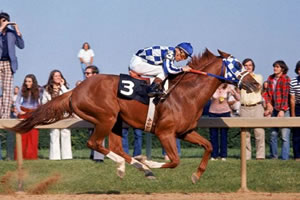
- Kentucky Derby: 1:59.4 (course record), 2.5 lengths
- Preakness Stakes: 1:54.4 (course record), 2.5 lengths
- Belmont Stakes: 2:24.0 (course record), 31 lengths (course record)
- Career Record: 21:16-3-1
- Inducted Into Hall of Fame: 1974
- Blood-Horse Magazine Top-100 Ranking: 2
- Career Winnings: $1,316,808 ($7,259,823)
There isn’t much to be said about Secretariat than hasn’t already been said. He was born at The Meadow in Caroline County, Virginia, in 1970. As the single most famous racehorse of all time, Secretariat is widely considered one of the best athletes in history – in any sport. He was the most dominant, singular phenomenon in horse racing history, and he set still-standing track records at all three of his Triple Crown races, ending a 25-year Triple Crown drought in spectacular fashion.
Despite his majesty, many horse racing aficionados rank Secretariat as the number-two racehorse in history behind Man o’ War, whose career spanned the late 1910s and early 1920s. (By all accounts, Man o’ War would have been a dominant Triple Crown champion but wasn’t allowed to run in the 1920 Kentucky Derby at his owner’s bizarre insistence. However, Man o’ War took the Preakness Stakes and the Belmont Stakes, winning the latter by 20 lengths, a record at the time that is currently held by Secretariat at 31 lengths.)
However, there is considerable debate in the race horsing community about this issue, with a great many historians recognizing Man o’ War for his siring prowess and pedigree history but giving the nod to Secretariat as the best-performing racer that ever lived. While there have been Triple Crown winners since Secretariat, none has ever commanded the awe of the world like Big Red (which, incidentally, was Man o’ War’s nickname, too). In fact, after Secretariat’s record-shattering Belmont win, 5427 winning betting slips were never redeemed, as witnesses to the event opted to keep their tickets as souvenirs.
Once his unmatched racing career was over, Secretariat was studded out, and – though he wasn’t considered a successful sire right away – he ultimately bred a line of highly-prized broodmares, and hundreds of horse racing winners can trace their bloodlines back to Secretariat (including the most recent Triple Crown winner, American Pharoah). Upon his death in 1989 at age 19, Secretariat was found to have a heart nearly three times larger than the average Thoroughbred. The doctor performing the necropsy described it as “perfect,” calling it a “huge engine.” Some horse racing historians believe that Secretariat’s large heart (not to be confused with the medically-perilous condition called an enlarged heart) is due to a genetic “x-factor” in the lineage of a specific bloodline going back to an 18th-century British champion named Eclipse, but there has been no conclusive research to this effect.
Regardless of the nature of Secretariat’s amazing physicality, he was ultimately responsible for his own success. He wanted to race, and he wanted to win, and so he did. Writer Charles Hatton famously quipped of Secretariat that “his only point of reference is himself.”
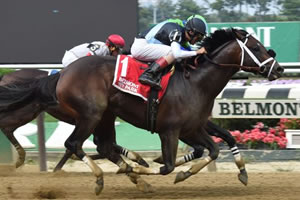
- Kentucky Derby: 2:02.2, 1.75 lengths
- Preakness Stakes: 1:54.4, 1.5 lengths
- Belmont Stakes: 2:29.6, 4 lengths
- Career Record: 17:14-2-0
- Inducted Into Hall of Fame: 1981
- Blood-Horse Magazine Top-100 Ranking: 9
- Career Winnings: $1,208,726 ($4,882,495)
Seattle Slew’s main claim to fame is his awesome name. Well, that and the fact that he won the Triple Crown in 1977 and is rated as the 9th greatest racehorse of all time. Born in 1974 at White Horse Acres Farm near Lexington, Kentucky, Seattle Slew was purchased at a yearling auction for just $17,500 (or $80,000 today), and his owners – Karen and Mickey Taylor, a working-class couple who just really liked horses – had him trained by a family friend.
For the 1977 Kentucky Derby, Seattle Slew was favored to win, and he edged out a 1.75-length victory. In the Preakness Stakes, many bettors and analysts picked speedster Cormorant to defeat Seattle Slew, but the latter prevailed, winning by 1.5 lengths. Seattle Slew took the Belmont Stakes in relatively uneventful fashion, winning by four lengths. To this day, Seattle Slew remains the only Triple Crown winner to be undefeated at the time of his coronation.
After going to stud, Seattle Slew was famed for his prized offspring, with his son Swale winning the Kentucky Derby and the Belmont Stakes, while his granddaughter Rags to Riches became only the third filly to ever win the Belmont. California Chrome, who won the first two legs of the Triple Crown in 2014, is Seattle Slew’s great-great-grandson. There are multiple Derby, Preakness, and Belmont winners in Seattle Slew’s direct bloodline. Fittingly (albeit in a bittersweet way), Seattle Slew died in his sleep on the 25th anniversary of his Kentucky Derby win. He was 28.
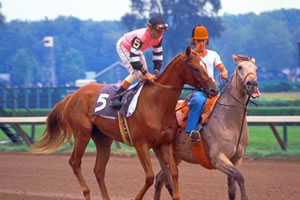
- Kentucky Derby: 2:01.2, 1.5 lengths
- Preakness Stakes: 1.54.4, neck
- Belmont Stakes: 2:26.8, nose
- Career Record: 29:22-5-1
- Inducted Into Hall of Fame: 1980
- Blood-Horse Magazine Top-100 Ranking: 12
- Career Winnings: $2,393,818 ($8,987,318)
Affirmed was the third Triple Crown winner of the 1970s (and the last for 37 years), taking the title in 1978. Affirmed is the only horse in history to win the Triple Crown the year after the prior Triple Crown winner (Seattle Slew, 1977). Born at Harbor View Farm in Marion County, FL, Affirmed had a number of major wins before and after his Triple Crown triumph. Still, he is mostly remembered for those three premier races, as he prevailed in each one, beating his career rival Alydar – arguably the greatest horse to never win a Triple Crown race – every time. (Alydar is the only horse to ever finish runner-up in the Kentucky Derby, Preakness Stakes, and Belmont Stakes, and Blood-Horse Magazine ranked him as the 27th greatest racehorse of the 20th century.) Many pundits rate Affirmed in the same class as Secretariat, simply because of this rivalry with another all-time great.
In the Kentucky Derby, Affirmed beat Alydar (the favorite) by 1.5 lengths. In the Preakness Stakes, Affirmed beat Alydar by a neck. In the Belmont Stakes, Affirmed beat Alydar by a nose. Affirmed thus won the Triple Crown by a total margin of less than two lengths, which remains a record. (Conversely, Alydar lost the Triple Crown by less than a combined two lengths, which is also a record.)
Affirmed retired to stud after becoming the first North American Thoroughbred to win more than $2 million in his career, and his stakes-winning and champion offspring have amassed purses of more than $50 million to date. Affirmed died in 2001 at the age of 25.
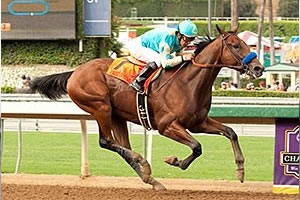
- Kentucky Derby: 2:03.02, 1 length
- Preakness Stakes: 1:58.46, 7 lengths
- Belmont Stakes: 2:26.65, 5.5 lengths
- Career Record: 11:9-1-0
- Inducted Into Hall of Fame: N/A
- Blood-Horse Magazine Top-100 Ranking: N/A
- Career Winnings: $8,650,300 ($8,933,841)
The most recent Triple Crown winner, American Pharoah – whose name is misspelled due to an alleged clerical error – won the circuit after a 37-year drought. Born on Groundhog Day in 2012 at Stockplace Farm in Lexington, KY, American Pharoah was put up for auction as a yearling. In an unusual move, breeder Ahmed Zayat bought back his horse at this auction for the posted minimum of $300,000.
American Pharoah was the favorite in the 2015 Kentucky Derby, but he was unexpectedly tested by the field and only won by 1 length. In the Preakness Stakes, American Pharoah was again the favorite, and he won in rainy conditions, beating the field by 7 lengths. At the Belmont Stakes, American Pharoah won by 5.5 lengths, leading from gate-to-wire. Notably, American Pharoah is the first and only horse to ever win the Triple Crown and the Breeder’s Cup Classic, a.k.a. the Grand Slam of Thoroughbred Racing. Due to American Pharoah’s success, The Jockey Club – which is the registrar of official horse racing names – has reserved both spellings (“American Pharoah” and “American Pharaoh”) from any future use.
Even with all his virile ability and success, American Pharoah is known as much for his calm, friendly temperament as for his racing prowess, and he is now retired to stud, with his first offspring just recently being born. Whether they can emulate their old man remains to be seen, but you can expect American Pharoah’s legacy to play a meaningful role in horse racing for many decades to come.